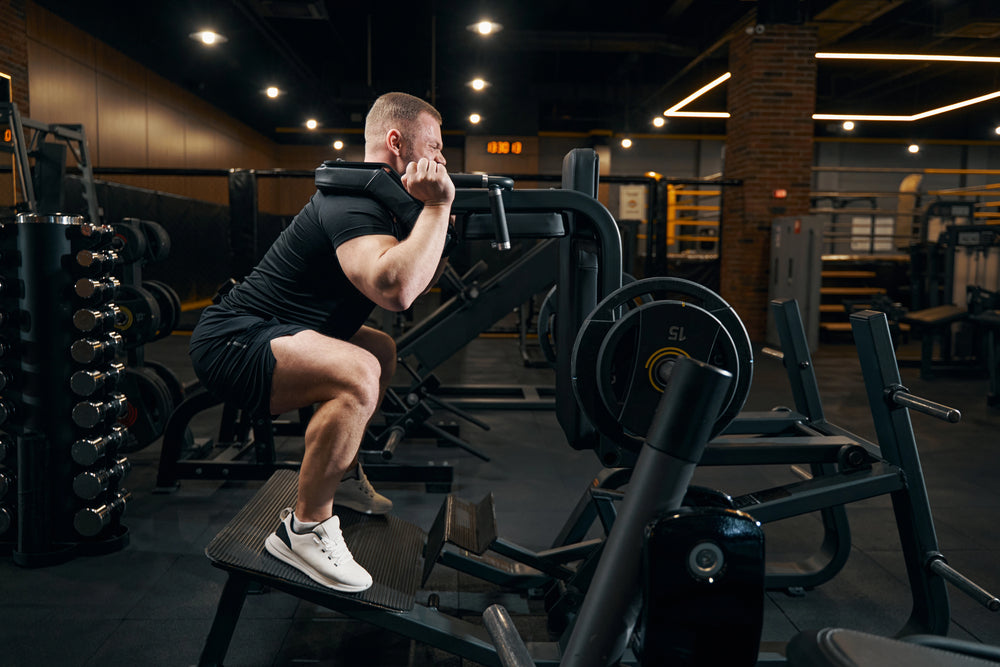
Mastering the Hack Squat: Benefits, Form, Mistakes to Avoid, and Powerful Alternatives
Share
The hack squat machine is a staple in most commercial gyms—and it’s increasingly finding its place in home gyms too. Favored by bodybuilders for its lower body-building potential and appreciated by beginners for its guided safety, the hack squat is a go-to leg day move for lifters of all levels.
Whether you're looking to add it to your routine or refine your technique, this all-in-one guide covers the benefits, form tips, common mistakes, and top alternatives so you can maximize your gains safely and effectively.
Why the Hack Squat Deserves a Spot in Your Routine
The hack squat targets your quadriceps, while also engaging your hamstrings and glutes. It provides a safer, more controlled environment than traditional free-weight squats, making it ideal for:
- Muscle hypertrophy (especially in the quads)
- Strengthening lower body without loading the spine
- Beginners who are learning proper squat mechanics
- Lifters managing back discomfort or limited mobility
Though the barbell back squat remains king for full-body strength and core engagement, research shows that machine-based movements like the hack squat offer similar hypertrophy potential when used correctly and consistently.
Who Should Use the Hack Squat?
Just about anyone looking to:
- Lose fat
- Build muscle
- Improve lower-body strength
- Train legs in a safer, controlled motion
However, those with existing knee or lower back issues should consult a doctor or physical therapist before incorporating hack squats into their routine.
Proper Hack Squat Form (Step-by-Step)
Different gyms may have slightly different machines, but the fundamentals of hack squat form remain the same.
1. Setup & Starting Position
- Load the machine with a manageable weight.
- Position your back and shoulders firmly against the pads.
- Keep your feet shoulder-width apart and slightly pointed outward.
- Maintain a neutral spine and brace your core.
- Unlock the machine and straighten your legs slightly without locking out the knees—this is your starting position.
2. Execution
- Inhale, then slowly lower yourself by bending the knees and hips.
- Aim for at least a 90-degree bend in the knees at the bottom.
- Exhale and drive through your heels, pressing the weight back up to the start.
- Focus on controlled movement—avoid bouncing or using momentum.
Bonus Tips for Better Results
Warm Up Thoroughly
Begin with bodyweight squats or light leg extensions before heavy hack squats. Warm-up sets improve joint health, performance, and injury prevention.
Improve Ankle Mobility
Poor ankle mobility can limit depth and increase injury risk. Spend a few minutes mobilizing your ankles pre-workout.
Engage Your Core
Just because it’s a machine doesn’t mean your core is off the hook. Bracing helps stabilize your spine and prevents injury—especially under heavy loads.
Recover Like a Pro
Recovery is half the game. Cool down, stretch, hydrate, and get high-quality protein in post-workout to maximize growth and performance.
Common Mistakes to Avoid
Going Too Heavy Too Soon
Don’t sacrifice form for ego. Start light and master your range of motion before stacking plates.
Using Momentum
Fast, sloppy reps reduce effectiveness and raise injury risk. Lower slowly and drive up powerfully for maximum muscle tension.
Looking Down
Keep your head neutral—not staring at your feet. Looking down can misalign your spine and throw off your balance.
How to Add Hack Squats to Your Routine
Because it’s a compound movement, the hack squat is best placed:
- Early in your workout (1st or 2nd exercise)
- When your energy levels are highest
- Depending on your goal:
- Strength: 5–8 reps
- Hypertrophy: 10–15 reps
- Endurance: 20+ reps (bring a towel—you’ll sweat!)
If your focus is on quads, prioritize hack squats early. If glutes or hamstrings are the main goal, slot them in later when your quads can act as secondary support.
No Machine? No Problem—Try These Alternatives
If you don’t have access to a hack squat machine, here are some powerful substitutions:
- Barbell Hack Squat: Deadlift-style lift with the bar behind you. Great for quad targeting. Use straps and a belt for safety.
- Front Squat: Barbell across the front of your shoulders. Challenges your core and shifts emphasis to the quads.
- Goblet Squat: Hold a dumbbell or kettlebell at chest level and squat down. Great for form and balance training.
- Leg Press Machine: Another machine-based compound movement that effectively targets quads and glutes.
- Smith Machine Hack Squat: Set your feet forward on the Smith machine for a modified hack squat experience.
- Reverse Hack Squat: Chest-facing version of the machine that targets glutes and hamstrings. Use with caution—only on machines designed for this setup.
Final Thoughts
The hack squat is one of the most effective, quad-dominant leg exercises you can do—especially if you're focused on muscle growth, strength, or building a rock-solid lower body.
Incorporate it into your routine with good form, thoughtful progression, and proper recovery, and you’ll be stacking gains—one leg day at a time.
Ready to get the most out of your next session? Mix in NO:NAME PURE CREATINE for better performance and recovery, and watch your leg day results soar.
